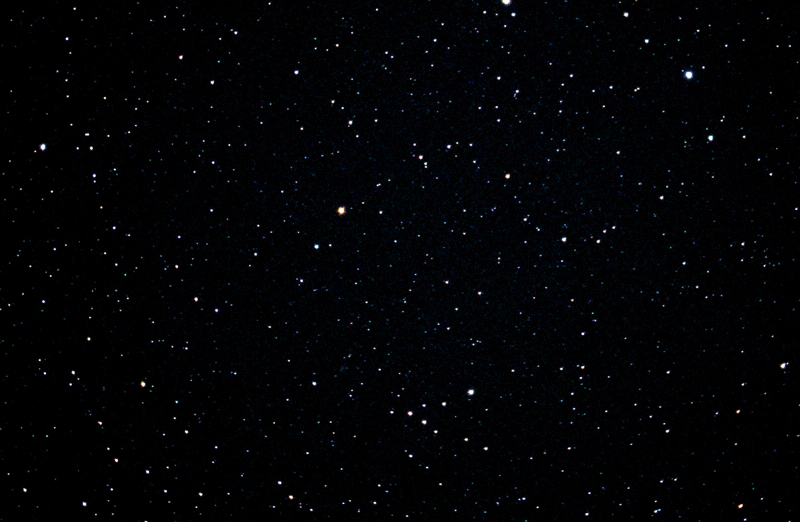
Even More Weather Notes,
Barnard's Star, Hercules Galaxies, Last Quarter Moon
Posted: 29 July 2013
Continuing my longest period of time of no observing at Cassiopeia Observatory due to cloudy skies, Thursday, 25 July 2013, saw more monsoon storms in the area. I posted a time-lapse video and still photo of one storm that was just west of the observatory but didn't move much in one hour.
Later the same day, two storms were near Picacho Peak, 31 miles to the west:

Friday mid-day had more monsoon storms in the area, with frequent thunder and a brief power outage. The storms essentially surrounded Cassiopeia Observatory, with some even severe with flash flooding. But only got some sprinkles of rain here. My live webcam did catch this nice lightning image during one of the storms:

It was a lucky shot! The webcam only uploads an image once a minute, and I happened to be saving uploaded images to a video in case of a storm.
Saturday, 27 July, had more monsoon storms in the area. One to the west late morning looked nice, as seen in this (cropped) fisheye lens photo:

The storm began intensifying so I decided to take a video of it using the D7000 DSLR and 8mm fisheye lens (180°) and managed to get this lightning on one frame:

The storm dropped 0.32" of rain on us in 30 minutes. I have posted two videos of the storms.
Sunday, 28 July, had a decrease in cloud thickness and monsoon storms, with even some blue sky, hinting at a possibility that the observatory could be opened that night. But, by mid-afternoon the teasing was over with and cloud cover began increasing. By 2230 MST, I noticed that the sky was mostly clear, and so after 31 nights of cloudy skies and no observing, I finally opened the observatory again at 2238 MST, 79°F. The sky was mostly clear.
I had initially planned to do some Milky Way imaging with the fisheye lens, but by the time I was ready clouds were in Sagittarius and Scorpius. Deferred to another night. I then viewed M16 (Eagle Nebula) at 83X. Good view. Next, I synced the observatory clock to WWV.
My primary objective for the night was to image Barnard's Star. I had last imaged it 17 June 2013. I hoped that with this long time between images, its large proper motion would be visible. This chart from SkySafari Pro for Mac OS X shows the star on 17 June:

I imaged the star field this night at the 8" LX200-ACF prime focus + focal reducer, using the D7000 DSLR, 30 seconds, ISO 6400:

I combined the 17 June and 28 July images into this animated GIF to do a "blink comparison":

No star motion "jumps out" at me. Although I had expected the image scale to show the motion, nothing was seen over this long period of time.
At 2326 MST, clouds were increasing in the south and east. At 2327 MST, I saw a Delta Aquarid meteor in the northwest sky.
I then set up to image NGC6050 (galaxy) at prime focus. I did a focus test on a star using the Bahtinov Mask with the D7000 mounted at prime focus using the Off-Axis Guider. I then slewed to NGC6050, found a faint guide star, and did a 1 minute, ISO 6400, framing test exposure of NGC6050, but could not see the galaxy in the image on the camera screen. I decided to try anyway and captured this 5 minute, ISO 6400, guided image:

NGC6050 appears at the top center edge. There are several other galaxies in the constellation of Hercules faintly visible in the image field-of-view. I will try again on the next session.
At this point, the clouds were now covering much of the eastern sky and the last quarter moon had risen. The combination of clouds and moon meant an end to this night's DSO imaging. I still have several more that I've been trying to do since the beginning of this period of cloudy nights.
At 0009 MST, slewed to M74 (galaxy) to check its position. I hoped to image the recent supernova SN 2013ej, however the galaxy was low, in the clouds, and very near the moon. I decided I would monitor the clouds for awhile to see if things improved.
At 0018 MST, slewed to the moon, still in the clouds. I checked the IR satellite image and could see a large band of clouds coming up from the south. I decided I would take a quick photograph of the moon at prime focus. This was taken at 0033 MST, 1/250sec, ISO 1250, with the moon visible through some thin clouds, still low in the east:

I gave up on further imaging at 0038 MST due to the clouds. At 0049 MST, took a quick look at the moon, 83X. I then slewed to M74, but nothing was visible in the eyepiece except moonlit clouds. Decided to close up for the night.
The observatory was closed at 0100 MST, 74°F. Even with the cloud-shorten session, it was great to be back in the observatory again.
On my previous report I mentioned that I had received an alert from CalSky.com about a transit of the sun by the Tiangong-1 Chinese space station on 28 July 2013. On 27 July, I checked the site, and apparently due to an orbital change, no transit would occur at my location on 28 July. In fact, instead of a transit, the space station would be over 1° from the sun at the time of its closest approach to the sun, which had shifted about 1 minute. And the sky was clear at the sun at the previously predicted transit time! Oh well, maybe next time.
Comments are welcome; use the Comments section below, or you can Email Me. Thanks.
Cassiopeia Observatory Home Page